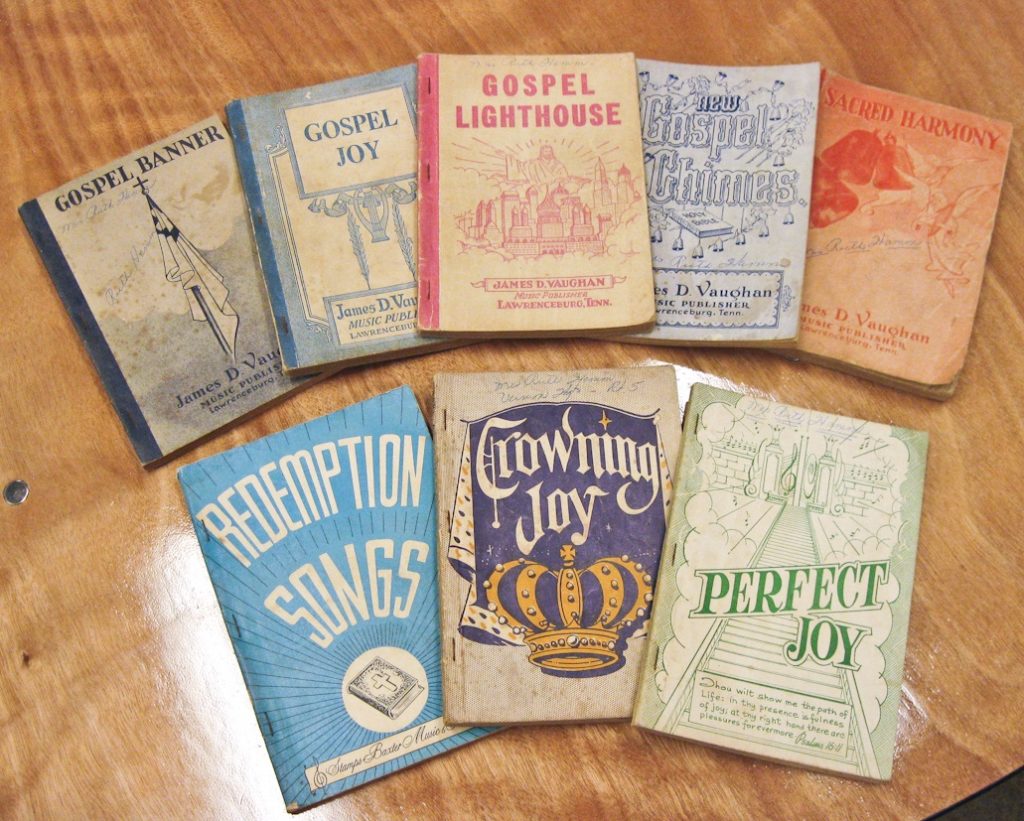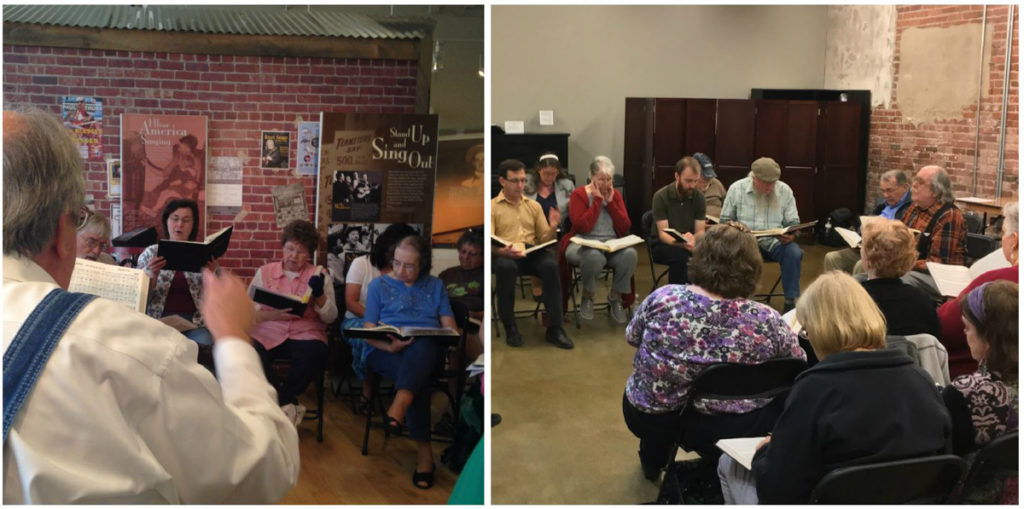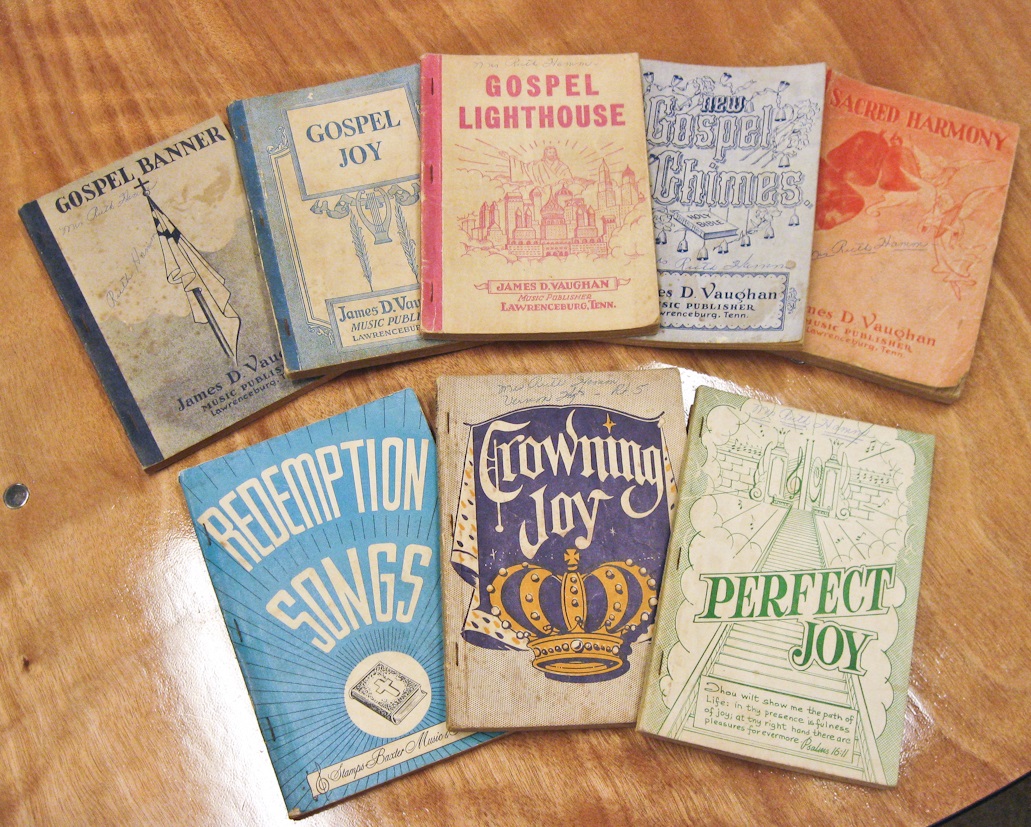By Hannah Arnett, September 26, 2017
Want to know what’s behind our closed museum vault door? With this occasional series, we take you behind the scenes to learn more about some of the interesting objects in our museum collections.
This Saturday, September 30, the Birthplace of Country Music Museum will be hosting a Shape Note Sing led by The Old Field Singers, an event that is free and open to the public – no singing experience necessary!
This event also provides us with a great opportunity to share part of our collection with you: shape note hymnals from the 1950s and 1960s, gifted to the museum by Dorothy Horne in memory of her mother, Ruth Hamm. I didn’t know much about shape notes before I did some research, but goodness, you don’t grow up Baptist without knowing somebody that remembers singing with shape notes. And I promise you, they’ll tell you all about it if you get them started.
The use of shape notes is rooted in the pre-Civil War South, and if you trace those roots back even further, you’ll find yourself in Great Awakening-era New England – though that’s a completely different blog post. For readers that don’t know, shape notes are a method of musical notation in which each tone is given a distinct shape and syllable to represent it. There are all sorts of shape note traditions, but Sacred Harp and Christian Harmony may be the most well known. The Sacred Harp tradition of shape note singing uses four syllables – fa, sol, la, mi – and four shapes. Christian Harmony – the tradition of The Old Fields Singers – uses seven shapes and seven syllables: do, re, mi, fa, sol, la, ti. Both schools are named for the “tunebooks” associated with them. If you want to learn more about the particulars of shape notes, this site may be a good place to start.

Vaughn’s Up-To-Date Rudiments and Music Reader was one of the songbooks used by Ruth Hamm when she attended J. M. Dixon’s singing school in Kingsport, Tennessee. Mr. Dixon’s singing school was part of a larger shape note tradition. In the mid-19th century, singing schools sponsored by local singing conventions gained popularity in the south. These sorts of schools used a seven-shape system and relied on “little-books.” James D. Vaughn and Stamps-Baxter music publishing companies were popular suppliers of these kinds of songbooks. They also supplied the bulk of Mrs. Hamm’s collection!
Mrs. Hamm, according to her daughter, sang her entire life. “Mom grew up singing,” Horne remembers. “Her father sang in a quartet. She sang in a quartet, and she took us with her on the practice sessions and all of the places they sang. She later sang with the Happy Day Singers at the Senior Center here in Kingsport.” Throughout her singing career, Mrs. Hamm accumulated a variety of songbooks – 43 of which are now in our collection. They contain some of the most recognizable sacred songs in the south (and anywhere, for that matter): “Victory in Jesus,” “Rock of Ages,” and of course, “Amazing Grace,” to name only a few. Horne has a special connection with one songbook in particular. “My favorite songbook is Lasting Glory and the song I remember so much is ‘I Feel Like Traveling On,’” she recalls. “It is on page 29. I can [still] see Mr. Dixon leading that song.”

Mrs. Hamm’s songbooks have been through a lot. They’ve been worn all around the edges, marked on, and creased, and some have even had a run-in with water. Those imperfections are part of what makes these songbooks so special: it’s apparent that they’ve been used over and over again. They are well loved. They tell us that singing with these hymnals was an important part of Mrs. Hamm’s life – and likewise, the lives of many that sang by shape notes throughout this region. For those that sang with shape notes, attending singing schools and community sings were once an integral part of keeping in touch with your neighbors. Some sources even indicate that the possibility of courting drew in young members – if they weren’t already “drew in” by their parents.
Community-driven shape note singing in the 1950s and 1960s saw a decline after gospel quartet performances became popular. Although the act of singing in church is still an essential part of the religious experience, there are not anywhere near as many singing schools as there once were. Don Wiley, leader of the Old Fields Singers, notes: “Although opportunities exist today, folks lead busy, even frantic lives.” Those busy days unfortunately mean that shape note singing isn’t as much a part of people’s lives now.
The social aspect of shape note singing might seem irrelevant in this age of social media, where people have more convenient ways to catch up with friends and can “court” with a few swipes on their phones. I asked Wiley what he thought the “most important” reason to continue the tradition of shape note singing was. Wiley gave me an interesting answer: “I can’t do ‘most important’…it seems that the singing itself either strikes a chord inside a person, or not.”
If you do some digging on YouTube, or better yet, join us at the Shape Note Sing on Saturday, I can almost guarantee you that the chord Wiley speaks of will resonate in you. There’s something irresistible about voices raised in gorgeous harmony, led only by a conductor and printed shapes on a page.

Hannah Arnett was an intern at the Birthplace of Country Music Musem in the summer of 2017. She is a senior museum studies and history student at Tusculum College, set to graduate in December 2017. You can learn more about Saturday’s Shape Note Sing here.


